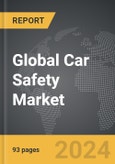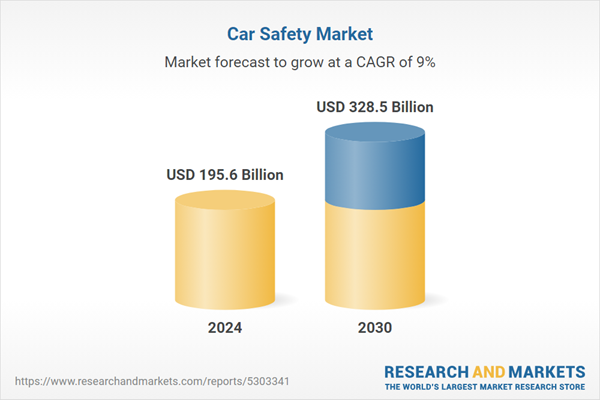Global Car Safety Market - Key Trends & Drivers Summarized
How Are Technological Innovations Revolutionizing Car Safety?
Technological innovations are at the forefront of transforming car safety, making modern vehicles safer than ever before. Advanced Driver Assistance Systems (ADAS) have become a standard feature in many new cars, incorporating technologies like lane departure warning, automatic emergency braking, blind-spot detection, and adaptive cruise control. These systems are designed to reduce human error, which remains a leading cause of accidents, by providing real-time assistance to drivers. For example, automatic emergency braking can detect potential collisions and apply the brakes if the driver fails to react in time, significantly reducing the risk of accidents. Similarly, lane departure warnings alert drivers when they unintentionally drift out of their lane, helping to prevent side collisions and off-road crashes.One of the most groundbreaking developments in car safety is the emergence of autonomous driving technologies. While fully autonomous vehicles are still in the testing phase, semi-autonomous systems, such as Tesla's Autopilot and GM's Super Cruise, are already in use. These systems combine sensors, cameras, and AI algorithms to assist with steering, braking, and acceleration, taking over many of the driving tasks in certain conditions. This evolution in safety technology is not only making driving more convenient but also paving the way for a future where human intervention in driving might be minimized, further enhancing road safety and reducing accident rates.
How Are Regulatory Trends and Government Initiatives Shaping Car Safety Standards?
Regulatory trends and government initiatives are playing a crucial role in shaping car safety standards worldwide. Governments in regions such as North America, Europe, and Asia are increasingly implementing stringent regulations aimed at reducing traffic-related fatalities and enhancing vehicle safety. For instance, in the European Union, the General Safety Regulation mandates that all new cars sold after 2022 must include advanced safety features such as driver drowsiness detection, intelligent speed assistance, and advanced emergency braking systems. Similarly, in the United States, the National Highway Traffic Safety Administration (NHTSA) has set rigorous standards for crash testing and vehicle safety technologies, pushing automakers to continually innovate and improve vehicle safety features.These regulatory measures are not just limited to passive safety features like seat belts and airbags but now also encompass advanced driver assistance systems and collision avoidance technologies. In developing countries, governments are increasingly adopting international safety standards, which is pushing local automakers to integrate advanced safety features into their vehicles. Moreover, various road safety campaigns and awareness initiatives are encouraging consumers to prioritize safety when purchasing vehicles. This focus on regulatory compliance and safety awareness is not only enhancing the overall safety of vehicles but also driving automakers to invest in research and development to meet the evolving safety standards.
What Role Does Consumer Behavior Play in the Growing Importance of Car Safety?
Consumer behavior is a significant factor driving the growing emphasis on car safety. As consumers become more informed about vehicle safety technologies, they are increasingly prioritizing safety features when making purchasing decisions. According to several market studies, safety has risen to the top of the list of features that buyers consider when choosing a vehicle, especially among families and young professionals. Consumers are no longer solely focused on aesthetics or performance; instead, they are looking for vehicles that offer a comprehensive suite of safety features designed to protect passengers in various driving conditions.This shift in consumer preference is partly driven by the rising awareness of road safety issues and the availability of crash test ratings and safety assessments provided by organizations like the Insurance Institute for Highway Safety (IIHS) and the European New Car Assessment Programme (Euro NCAP). With these independent ratings widely accessible online, consumers are becoming more discerning, opting for cars that score highly on safety tests. Additionally, the increasing demand for SUVs and electric vehicles (EVs) has led automakers to introduce more robust safety systems tailored to the unique characteristics of these vehicle types, further shaping the car safety landscape.
Growth in the Car Safety Market Is Driven by Several Factors
Growth in the car safety market is driven by several factors, including advancements in automotive technology, regulatory requirements, and changing consumer preferences. One of the key drivers is the rapid evolution of ADAS and autonomous driving technologies, which are being integrated into a growing number of vehicles. These technologies are increasingly seen as essential by both consumers and regulators, as they significantly reduce the likelihood of human error, which is a major contributor to road accidents. As automakers continue to develop and refine these systems, the market for safety technologies is expected to expand further, particularly as semi-autonomous features become standard in mid-range and budget vehicles.Another significant factor driving growth is the increasing regulatory pressure on automakers to comply with enhanced safety standards. Governments around the world are implementing stricter vehicle safety regulations, compelling manufacturers to integrate advanced safety features into their models. In addition, the growing consumer awareness of safety ratings and crash-test performance is influencing vehicle purchasing behavior, with more buyers willing to pay a premium for vehicles equipped with comprehensive safety systems. The rise of electric vehicles (EVs) is also driving demand for specialized safety solutions, as the unique design and technology of EVs require tailored safety features to protect passengers and manage battery risks. As these trends converge, the car safety market is poised for continued growth, with innovation, regulation, and consumer demand all playing pivotal roles.
Report Scope
The report analyzes the Car Safety market, presented in terms of market value (US$ Thousand). The analysis covers the key segments and geographic regions outlined below.- Segments: Application (Active Safety, Passive Safety).
- Geographic Regions/Countries:World; United States; Canada; Japan; China; Europe (France; Germany; Italy; United Kingdom; and Rest of Europe); Asia-Pacific; Rest of World.
Regional Analysis
Gain insights into the U.S. market, valued at $54.7 Billion in 2024, and China, forecasted to grow at an impressive 8.4% CAGR to reach $50.3 Billion by 2030. Discover growth trends in other key regions, including Japan, Canada, Germany, and the Asia-Pacific.Why You Should Buy This Report:
- Detailed Market Analysis: Access a thorough analysis of the Global Car Safety Market, covering all major geographic regions and market segments.
- Competitive Insights: Get an overview of the competitive landscape, including the market presence of major players across different geographies.
- Future Trends and Drivers: Understand the key trends and drivers shaping the future of the Global Car Safety Market.
- Actionable Insights: Benefit from actionable insights that can help you identify new revenue opportunities and make strategic business decisions.
Key Questions Answered:
- How is the Global Car Safety Market expected to evolve by 2030?
- What are the main drivers and restraints affecting the market?
- Which market segments will grow the most over the forecast period?
- How will market shares for different regions and segments change by 2030?
- Who are the leading players in the market, and what are their prospects?
Report Features:
- Comprehensive Market Data: Independent analysis of annual sales and market forecasts in US$ Million from 2024 to 2030.
- In-Depth Regional Analysis: Detailed insights into key markets, including the U.S., China, Japan, Canada, Europe, Asia-Pacific, Latin America, Middle East, and Africa.
- Company Profiles: Coverage of players such as 5 Robert Bosch GmbH, Autoliv Inc, Continental AG, Delphi Automotive PLC, Denso Corporation and more.
- Complimentary Updates: Receive free report updates for one year to keep you informed of the latest market developments.
Some of the 42 companies featured in this Car Safety market report include:
- 5 Robert Bosch GmbH
- Autoliv Inc
- Continental AG
- Delphi Automotive PLC
- Denso Corporation
- Johnson Electric Holdings Limited
- Robert Bosch GmbH
- Takata
- Toyoda Gosei Co., Ltd.
- Valeo
- ZF TRW Automotive Holdings Corporation
This edition integrates the latest global trade and economic shifts into comprehensive market analysis. Key updates include:
- Tariff and Trade Impact: Insights into global tariff negotiations across 180+ countries, with analysis of supply chain turbulence, sourcing disruptions, and geographic realignment. Special focus on 2025 as a pivotal year for trade tensions, including updated perspectives on the Trump-era tariffs.
- Adjusted Forecasts and Analytics: Revised global and regional market forecasts through 2030, incorporating tariff effects, economic uncertainty, and structural changes in globalization. Includes historical analysis from 2015 to 2023.
- Strategic Market Dynamics: Evaluation of revised market prospects, regional outlooks, and key economic indicators such as population and urbanization trends.
- Innovation & Technology Trends: Latest developments in product and process innovation, emerging technologies, and key industry drivers shaping the competitive landscape.
- Competitive Intelligence: Updated global market share estimates for 2025, competitive positioning of major players (Strong/Active/Niche/Trivial), and refined focus on leading global brands and core players.
- Expert Insight & Commentary: Strategic analysis from economists, trade experts, and domain specialists to contextualize market shifts and identify emerging opportunities.
Table of Contents
Companies Mentioned (Partial List)
A selection of companies mentioned in this report includes, but is not limited to:
- 5 Robert Bosch GmbH
- Autoliv Inc
- Continental AG
- Delphi Automotive PLC
- Denso Corporation
- Johnson Electric Holdings Limited
- Robert Bosch GmbH
- Takata
- Toyoda Gosei Co., Ltd.
- Valeo
- ZF TRW Automotive Holdings Corporation
Table Information
| Report Attribute | Details |
|---|---|
| No. of Pages | 126 |
| Published | December 2025 |
| Forecast Period | 2024 - 2030 |
| Estimated Market Value ( USD | $ 195.6 Billion |
| Forecasted Market Value ( USD | $ 328.5 Billion |
| Compound Annual Growth Rate | 9.0% |
| Regions Covered | Global |









